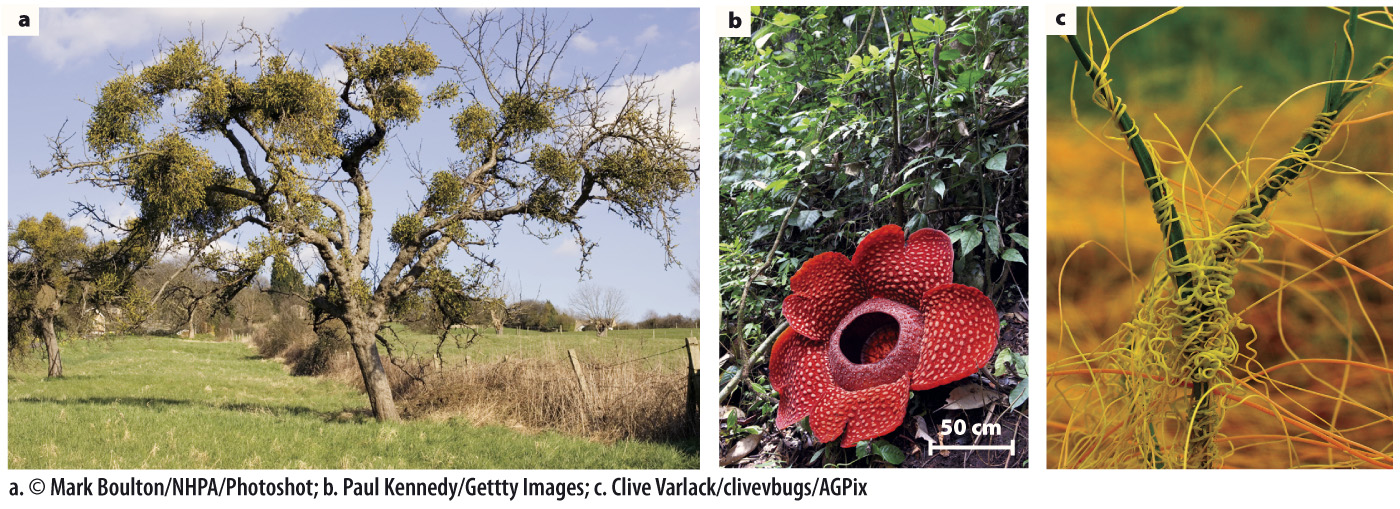Plant pathogens infect and exploit host plants by a variety of mechanisms.

The epidermis, with its thick walls and waxy cuticle, is a plant’s first line of defense against pathogens. Viruses and bacteria cannot penetrate the cuticle and so commonly enter through wounds or on the piercing mouthparts of insects and nematodes. Stomata form a natural entry point for bacteria, oomycetes, and fungi (Fig. 32.2). Some bacteria and fungi even secrete chemicals that prevent stomata from closing. Other pathogens, notably parasitic plants and some species of fungi, secrete enzymes that weaken epidermal cell walls. These invaders then force their way through the weakened epidermis. Mechanical cultivation can damage crop plants, thus also providing entry points for pathogens.
Once inside the plant, fungi can spread by growing through plant cell walls. In contrast, viruses move from one plant cell to another through plasmodesmata. Because the genomes of most plant viruses are single strands of RNA, they can travel by the plant’s natural mechanism for moving messenger RNA between cells. The plant vascular system provides a highway that allows pathogens to move over long distances. Viruses are transported within the phloem, whereas bacteria and fungi move through the xylem. During the 1950s, commercial banana production in Mesoamerica was nearly wiped out by Fusarium oxysporum, a fungal pathogen whose spores are carried in the xylem. More recently, the California wine industry has been threatened by Pierce’s disease, which results from infection by Xylella fastidiosa, a bacterium that also moves through the xylem.
Biotrophic pathogens obtain resources from living cells, whereas necrotrophic pathogens kill cells before exploiting them. Most biotrophic pathogens do not enter into the host plant’s cells. Instead, they produce chemicals that stimulate the host cells to secrete compounds that the pathogen can use as food. Viruses, however, are biotrophic pathogens that do enter the cell: They must hijack a living cell’s machinery to reproduce. Necrotrophic pathogens produce toxins that kill cells; the pathogens then feed on compounds that leak from the dead and dying cells. Bacteria and fungal pathogens can be either biotrophic or necrotrophic. For example, wheat leaf rust (Puccinia species) is a biotrophic fungus that significantly reduces wheat yields (Chapter 34). Rice blast (Magnaporthe grisea) is a necrotrophic fungus that each year reduces rice production by an amount that would feed 60 million people.
Parasitic plants obtain resources by infecting other plants (Fig. 32.3). Parasitic plants produce structures that penetrate into the stems or roots of other plants, eventually tapping into the host plant’s vascular system. Some, like some mistletoes (Fig. 32.3a), are xylem parasites: They obtain water and nutrients from the xylem of the host plant without expending the costs of producing roots themselves. Other plant pathogens target both the xylem and the phloem. In the most extreme cases, the parasite receives all its carbohydrates from its host and carries out no photosynthesis of its own. Rafflesia (Fig. 32.3b), famous for producing the largest flower in the world, grows entirely within the tissues of its host, emerging only when it produces its giant flowers. The ability to parasitize other plants has evolved independently multiple times. Currently, more than 4000 species of parasitic plants have been identified.

How do parasitic plants find an appropriate host? Mistletoe fruits, which are eaten and dispersed by birds, have a sticky layer that adheres to the stems and branches of trees that the plant will parasitize. Dodder, a parasitic vine (Fig. 32.3c), orients its growth toward a potential host plant, guided by volatile organic compounds produced by the species it infects. One of the most destructive plant pathogens is witchweed (Striga species), which infects the roots of a number of crop species, including corn, sorghum, and sugarcane. Striga seeds remain dormant in the soil until their germination is triggered by chemicals released from the roots of host species. Striga infects more than 40% of all agricultural areas in Africa, driving down crop yields, in some cases to zero.